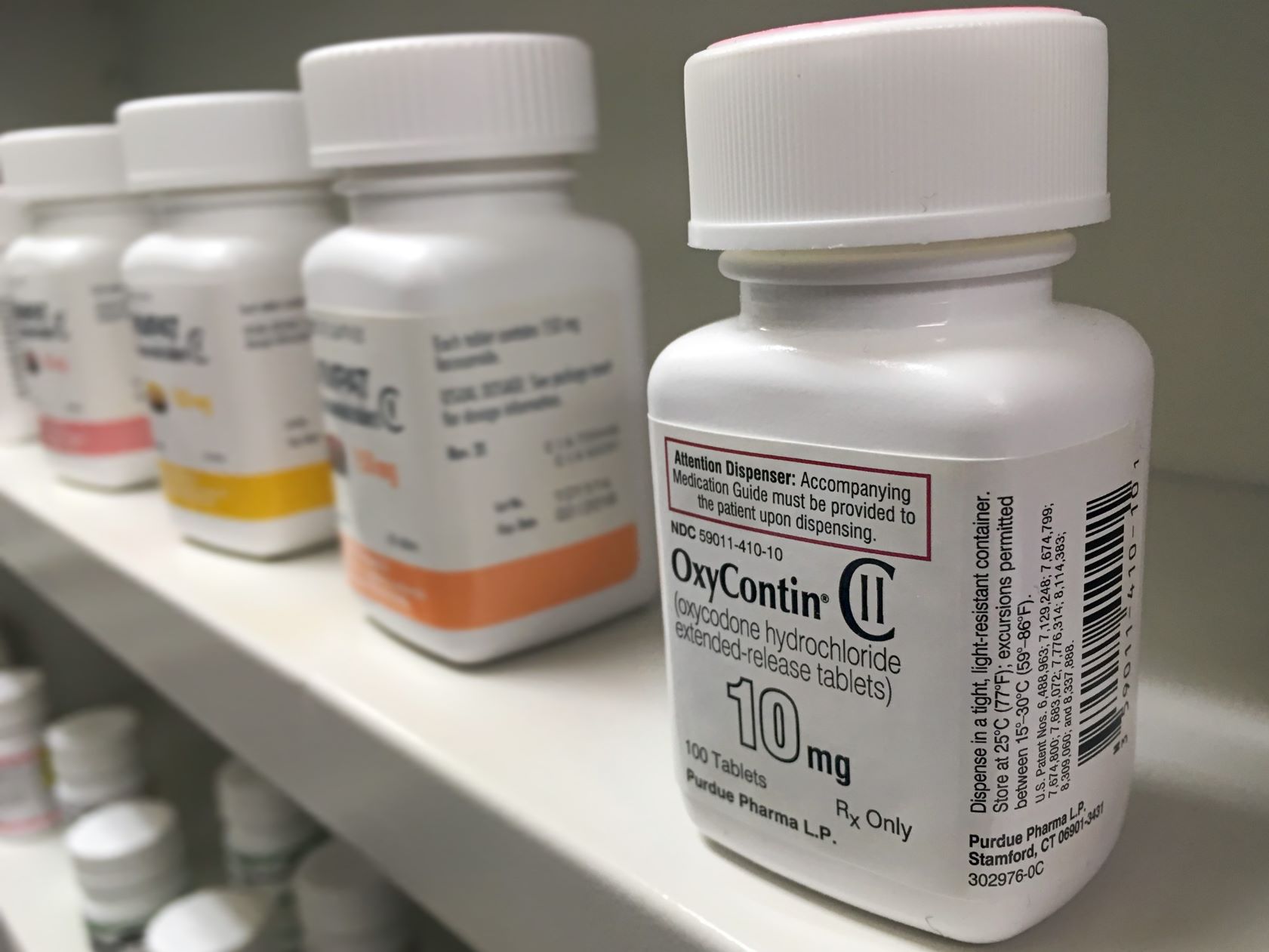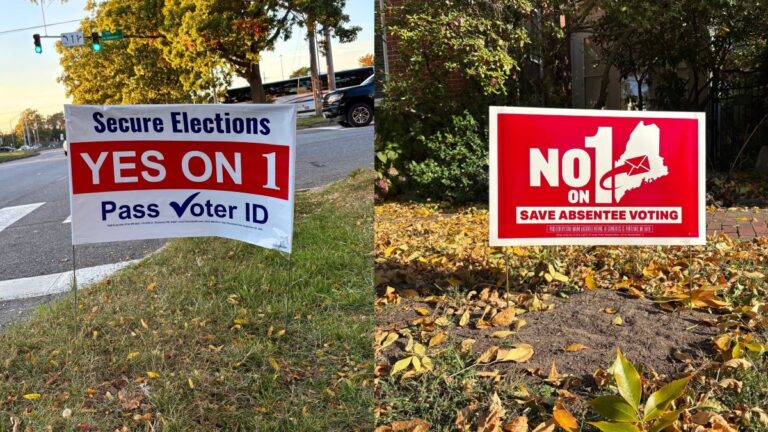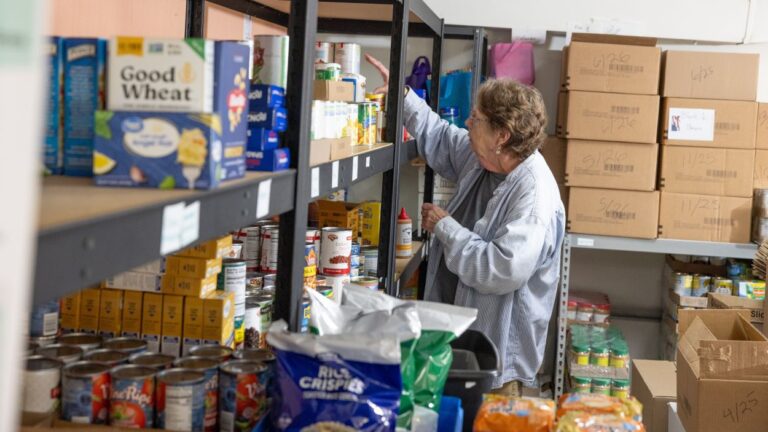Maine stands to receive at least $235 million over the next nearly two decades as the result of national settlements with some of the companies accused of supercharging the opioid epidemic.
The settlements end years of litigation filed by dozens of states and other plaintiffs against the companies, alleging they led a misleading, dangerous and ultimately deadly campaign for more than two decades to put pharmaceutical opioids into the medicine cabinets of people across the country.
This campaign, the plaintiffs say, created the opioid crisis and contributed to the situation that saw 105,000 people die of drug overdoses in the United States last year, largely fueled by increasingly lethal drugs like the synthetic opioid fentanyl. More than 932,000 people have died from a drug overdose between 1999 and 2020, according to the latest data from the U.S. Centers for Disease Control and Prevention. Nearly two-thirds of those deaths involved an opioid.
“Our communities have suffered tremendously,” Maine Attorney General Aaron Frey said in a statement last December.
“While no amount of money can ever remedy the pain experienced by so many, I’m hopeful that a settlement could mean more funds for critical treatment, prevention and recovery efforts that can make a meaningful difference in lives across the state,” he said.
The complicated task of how to distribute the money to municipalities, recovery groups and others has begun in Maine. The state has received approximately $28 million with millions more expected.
The Maine Monitor examined the web of legal agreements and spoke to key players to understand who stands to benefit from this money and why it matters.
Purdue Pharma’s role
To understand the significance of these settlements, it requires going back to December 1995, when the U.S. Food and Drug Administration approved OxyContin, Purdue Pharma’s extended-release formulation of the powerful synthetic opioid oxycodone.
The formulation doled out the drug every 12 hours instead of every four to six. The FDA by its own admission said at the time it believed this formulation “would result in less abuse potential, since the drug would be absorbed slowly and there would not be an immediate ‘rush’ or high that would promote abuse.”
Oxycodone, however, is a highly addictive substance, one-and-a-half times more powerful than morphine and hydrocodone. And someone looking to get that rush could easily bypass the controlled-release mechanism by crushing or dissolving the pills, which ranged from 10 to 160 milligrams, to snort or inject.
The FDA said there was “no evidence to suggest at the time” that doing so “would become widespread and lead to a high level of abuse.”
Over the years, Purdue spent hundreds of millions of dollars on an aggressive marketing campaign. Drug representatives camped out in doctor’s offices to offer lavish lunches, free gifts and a chance to hear about Purdue’s new wonder drug. Unsealed documents show the manufacturer often targeted primary care physicians with little to no formal training in pain medicine.
They encouraged providers, many initially reluctant to prescribe an opioid painkiller, to think of pain as the “Fifth Vital Sign” and pushed the misleading claim that “less than 1% of patients” treated with an opioid became addicted, according to court documents and reporting.
In 1997, just one year after OxyContin came on the market, 30 people in Maine died from a pharmaceutical drug overdose, 16 involving opioids, according to reports from the University of Maine Margaret Chase Smith Policy Center. In all, 34 Mainers died from a drug overdose that year.
Last year, 715 Mainers died of drug overdoses. Slightly more than a fifth, or 155 deaths, involved pharmaceutical opioids, alone or in combination with other drugs. Illicitly manufactured fentanyl, which first showed up in toxicology reports in Maine in 2013, claimed nearly 80% of drug deaths in 2022. There were 9,859 reported nonfatal overdoses, though that number is likely higher.
This April alone there were nearly 800 fatal and nonfatal overdoses in Maine.
“Purdue and the Sackler defendants misled Maine consumers, and in doing so played a significant role in accelerating the opioid epidemic,” Frey said in a June 2019 statement announcing he had filed a complaint against the OxyContin manufacturer and its billionaire owners, members of the Sackler family.
“Our complaint alleges that their unrelenting sales visits to doctors and deceptive practices led to a marked increase in opioid prescriptions, and a corresponding increase in the number of Mainers suffering from opioid use disorder,” he said.
In filing suit, Maine joined nearly every other state, plus about 2,000 local and tribal governments, in pursuing legal action against Purdue, Frey said.
The settlements
Maine’s suit was just one of thousands of complaints filed against Purdue and other companies accused of fueling the opioid epidemic. The lawsuits have been playing out in courts across the country for years. Nationwide, they have led to some $50 billion in settlements.
In 2017, a federal judicial panel ordered that thousands of pending lawsuits be consolidated into a massive multidistrict litigation case called the National Prescription Opiate Litigation. In 2021, a $26 billion settlement agreement was reached with the “big three” wholesale pharmaceutical companies who distribute 80-90% of all prescription drugs in the United States — McKesson Corporation, AmerisourceBergen and Cardinal Health — and pharmaceutical manufacturer Johnson & Johnson and its subsidiary, Janssen Pharmaceuticals.
Maine signed on to the agreement and in January 2022 executed a “Memorandum of Understanding” with political subdivisions — counties, towns and cities — and separate MOU with school districts that were part of the consolidated opiate litigation case. Maine stands to receive at least $130 million over the next nearly two decades from this batch of settlements involving the “Big Three” and Johnson & Johnson.
Litigation against Purdue has yet to reach its conclusion. In September 2019, the company filed for Chapter 11 bankruptcy, just days after reaching a tentative settlement with more than 2,000 local governments. Purdue’s bankruptcy case remains caught up in appeals, with the latest decision in a federal appeals court, granting members of the Sackler family legal immunity, coming down late last month.
Separately, Maine was part of a multistate agreement with manufacturer Mallinckrodt, which filed for Chapter 11 bankruptcy in 2020. Maine is slated to receive $5.8 million over nine years under that agreement, which will also be governed by the MOUs.
About $819,000 in payments have already been made to Maine in the Mallinckrodt case, though future payments may be in limbo: Earlier this month, Mallinckrodt floated the possibility that the company could file for a second bankruptcy.
In March, Frey announced another $100 million in payments as part of five additional settlements reached earlier this year. The settlements are with manufacturers Teva and Allergan, and three retailers, CVS, Walgreens and Walmart.
Frey’s office confirmed earlier this month that 100% of eligible subdivisions — all 16 of Maine’s counties, and 23 cities and towns — have signed on to the five additional agreements, which will pay out over 15 years.
One pending settlement remains: Endo International, a manufacturer, filed for Chapter 11 bankruptcy last August. While the restructuring process remains in progress, Frey’s office said last week it expects about $500 million to be distributed to states, though the exact allocation hasn’t been determined.
“There’s a lot of money here and there’s also a lot to learn in regards to how the money can be spent and what the money can be spent on,” Pat Kimball, the chair of the Maine Recovery Council, which oversees half of the money coming into the state, said earlier this month.
Another $3.3 million will go to Maine’s five federally recognized tribes over 15 years as part of a separate set of agreements between Native American tribes and tribal health organizations and the same companies. The Maine Monitor’s analysis does not include those agreements.
‘Due diligence’
Although payments from the Distributors and Johnson & Johnson settlements brought in approximately $28 million since last year, some recipients are getting restless with the slow progress to actually put dollars toward combating the opioid crisis, according to some involved in the process.
Yet the Maine Recovery Council — which has yet to disburse any of the approximately $14.5 million already in its coffers — insists it’s doing “due diligence,” Kimball, the council chair, said earlier this month.
A Hermon resident, Kimball retired in 2016 after 15 years as executive director of Wellspring in Bangor, which provides inpatient and outpatient mental health and substance use disorder counseling.
“As frustrated as everyone is, including the Council members, it takes time,” Kimball said. “And we’re trying to push it as quickly as we can, but at the same time being responsible to make sure that these dollars are well spent.”
The council has met nearly every month since its first meeting last November, though the MOU only requires they meet twice annually. At its latest meeting June 8, the council was still settling into its role overseeing what will amount to nearly $118 million in settlement payments over the next decade and a half, spending most of the meeting discussing officer elections, potential subcommittees and a remote meeting policy.
There was no discussion during the 90-minute meeting on how to disburse the funds and to whom.
Kimball said the council is focused on “getting ourselves organized” and “getting to know what’s going on around the state” to understand where funding gaps exist.
“Part of it is that we want to spend this money, we want it to get to people, we want to save lives. But at the same time we don’t want to put money where money has already been spent,” she said.
The council needs to create a “fair process as to how people can tell us, to share with us, what their needs are.”
Asked about a timeline for when the council expects to have a process to begin disbursing funds, Kimball said her goal would be by the fall.
“I’m not sometimes a patient woman. Sometimes I think the process is slow. But I also know from experience that slow and steady wins that race,” she said.
Because the direct share subdivisions do not have public reporting requirements, it is not immediately clear how each of the 39 counties, cities and towns have spent or plan to spend the $9 million already paid out.
Council members at the June 8 meeting said they heard from some counties and towns that they don’t know where to even begin.
“There’s a lot of collaboration, a lot of conversations that need to be taking place,” said Bruce Noddin, the founder and executive director of the Maine Prisoner Re-Entry Network.
“Municipalities are in the dark right now. They have no idea what they’re doing and they’re just begging for somebody to give them some guidance. And they want to collaborate,” he said.
A spokesperson for the Office of the Attorney General said they have spent a portion of the approximately $5.8 million it received as of the spring, but did not provide a detailed breakdown.
“The Attorney General will continue to work closely with the legislature, the Mills administration, community partners and impacted communities to use the settlement funds allocated to the Office to enhance treatment, prevention, recovery and harm reduction efforts across the state,” according to a statement provided by spokesperson Danna Hayes.
“The AG has already committed over $4 million to expand family drug court dockets and the OPTIONS program, in addition to the naloxone the Office has been purchasing and distributing to law enforcement agencies across Maine since 2016. The OAG’s share of the settlement funding is, by design, intended to be flexible and responsive to meet urgent programming and resource needs and as such, the OAG will be paying close attention to opportunities to make an impact for Maine communities.”
Who are the settlement agreements with, and how much money will Maine receive?
The “big three” wholesale pharmaceutical companies, Texas-based McKesson Corporation, Pennsylvania-based AmerisourceBergen and Ohio-based Cardinal Health, collectively known as the “Distributors,” will pay $106.7 million to Maine over 18 years. Payments began last fall and total about $10.7 million so far.
New Jersey-based pharmaceutical manufacturer Johnson & Johnson and its subsidiary, Belgium-based Janssen Pharmaceuticals, will pay $24.6 million over nine years. Payments began last fall and total about $16.8 million so far.
Maine expects to receive about $5.8 million as part of manufacturer Mallinckrodt’s bankruptcy restructuring plan, which has its operational headquarters in Missouri. The state has already received $819,000.
Allergan, a global pharmaceutical manufacturer headquartered in Ireland, will pay $11.3 million over seven years beginning this year.
Teva, an Israeli multinational pharmaceutical manufacturer, will pay $20.5 million over 13 years beginning this year.
Rhode Island-based CVS Pharmacy, the largest pharmacy chain in the U.S., will pay $25 million over 10 years beginning this year.
Illinois-based Walgreens, the second-largest pharmacy chain in the U.S., will pay $27.3 million over 15 years starting this year.
Walmart, the Arkansas-based multinational retail corporation and pharmacy chain, will pay its entire $14.2 million settlement this year.
Who controls the money?
Maine has two memoranda of understanding with the political subdivisions and school districts that were independent of the Attorney General’s complaints party to the multidistrict litigation.
These MOUs determine which bank accounts the money is deposited into, how the money can be allocated or spent and any oversight. The settlement payments, with some caveats, are divided as such:
20% to the Office of the Attorney General, which will oversee the “state fund.”
30% to the litigating subdivisions (the “subdivision fund”), otherwise known as “direct share subdivisions.” Payments from the settling companies or trusts go directly to these 39 counties, cities and towns.
50% to the Maine Recovery Council, which oversees the Maine Recovery Fund, or “abatement fund.” (More on this later.)
The caveats:
To pay for litigating subdivisions’ attorney fees, the settlement agreements for the Distributors and Johnson & Johnson state that 7% of their payments must go into a “backstop fund.” Each subdivision’s allocation is calculated from the net total (the total subdivision fund minus the backstop fund.)
Per the MOU with school administrative districts, at least 3% of the Maine Recovery Fund must go to school districts for special education purposes. The MOU states that any school district can apply, but the 30 litigating school districts will be given a “reasonable plus factor in consideration of grants.”
What’s the Maine Recovery Council?
The 15-member Maine Recovery Council will oversee the Recovery Fund, which accounts for 50% of all payments coming to Maine. Gov. Janet Mills signed into law LD 1722 in April 2022, establishing the council. The MOUs govern the scope and power of the council.
The members are appointed by the governor, Senate President, House Speaker, litigating subdivisions and the Office of the Attorney General, and are limited to two consecutive two-year terms.
The council’s primary task is to distribute the Recovery Fund and ensure that the funds are being spent in compliance with the MOU. While it has no rulemaking authority, the MOU also tasks the council with facilitating “collaboration” among the state, subdivisions and other “stakeholders for the purposes of sharing data, outcomes, strategies and other relevant information related to abating the opioid crisis in Maine.”
How can the money be spent?
The settlement funds must be used for opioid abatement strategies. Examples of abatement strategies are treatment and prevention, such as the expansion of medication-assisted treatment for uninsured individuals or harm reduction initiatives, like education on and distribution of the opioid overdose-reversing drug naloxone. Other strategies include research, training and technical assistance.
The state subdivision MOU provides a list of potential strategies that come directly from the National Opioid Settlement and filings from the Purdue Pharma bankruptcy case.
Does spending have to be publicly reported?
Only 15 states have explicitly promised to publicly report 100% of their settlement expenditures, according to a 50-state survey from OpioidSettlementTracker.com author Christine Minhee. Maine is not one of them.
Maine has only committed to publicly reporting on 50% of its settlement expenditures, all from the Maine Recovery Council, which oversees the Maine Recovery Fund. The council is required to develop a “centralized public dashboard or other repository for publication of expenditure data,” according to the MOU. The council can request fund recipients submit certain data, including on outcomes to support this.
The Recovery Fund also appears to be the only bucket of money with any reporting requirements. This includes various annual reports to the state legislature from the Attorney General, whose office provides legal counsel and administrative support to the council.
There are no requirements under Maine law or the MOUs that the Office of the Attorney General or the direct share subdivisions publicly disclose how they are spending settlement money.







